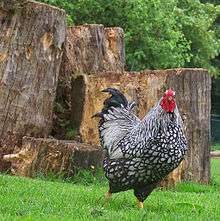Wyandotte chicken
 The silver-laced is the original variety of the breed. | |
| Conservation status | Not at risk[1] |
|---|---|
| Other names | American Sebright (before 1883)[1] |
| Country of origin | United States |
| Use | Dual-purpose |
| Traits | |
| Weight | Male: 3.5–4 kg (8–9 lb)[2] |
| Female: 2.7–3.2 kg (6–7 lb)[2] | |
| Skin color | Yellow |
| Egg color | Brown |
| Comb type | Rose |
| Classification | |
| APA | American[3] |
| EE | yes[4] |
| PCGB | Soft Feather: Heavy[5] |
|
Chicken Gallus gallus domesticus | |
The Wyandotte is an American breed of chicken developed in the 1870s. It was named for the indigenous Wyandot people of North America.[6] The Wyandotte is a dual-purpose breed, kept for its brown eggs and its yellow-skinned meat.[6] It is a popular show bird, and has many color variants.[4] It was originally known as the American Sebright.[1]
History
The Wyandotte was created in the United States in the 1870s by four people, H. M. Doubleday, John Ray, L. Whittaker and Fred Houdlette.[6] The first type was the silver-laced, which was included in the American Standard of Perfection in 1883; it was taken to Britain at about the same time.[2]:311 The origin of the breed is still somewhat a mystery, however silver spangled Hamburgs and dark Brahmas are considered to be important breeds in the initial crosses to developing the Wyandotte.[7]The Hamburg was used for the rose comb and the Brahma for the color pattern. Prior to the breed’s acceptance into the Standard of Perfection, the breed was referred to as the “Sebright Cochin” and “American Sebright”.[7] The gold-laced Wyandotte was produced by breeding silver-laced hens with gold-spangled Hamburg and partridge Cochin cocks, the white Wyandotte was a sport of the silver-laced, and the buff variant came from crossing the silver-laced with buff Cochin stock;[2]:311 the black variant was also a sport, of both the silver-laced and the gold-laced.[6] The partridge Wyandotte came from crossing the gold-laced with Indian Game, partridge Cochin, gold-pencilled Hamburghs, and a strain called "Winnebago".[6] The Columbian was the result of a chance crossing of white Wyandottes with barred Plymouth Rock birds; it was named for Columbian Exposition and World's Fair in Chicago, Illinois in 1893.[6][2]:311 The first Wyandotte bantams were added to the Standard of Perfection in 1933.[3]
In 2015 the Wyandotte was listed as "recovering" by the American Livestock Conservancy;[8] in 2016 it was no longer considered to be in danger and was removed from the priority list.[1] In Germany it is listed in category IV, "alert", on the Rote Liste of the Gesellschaft zur Erhaltung alter und gefährdeter Haustierrassen.[9]
Characteristics
The Wyandotte is a fairly large bird, but compact and rounded. The weight range is variable but typically 5 ½ to 8 ½ pounds for pullets to cock birds respectively.[7] The breast is deep, full and well rounded. The body of a Wyandotte is described as medium length but very wide, carrying that width across the back and into the tail.[7] It is clean-legged and fairly close-feathered, and has a broad skull with a rose comb.[2]:311 The skin and shanks are yellow,[6] and the ear-lobes, face and wattles are red.[1]
Silver-laced Wyandotte cocks may occasionally display hen feathering.[10]:85–86
Colors
In the United States, nine colors are recognized in the Standard of Perfection of the American Poultry Association: black (1893), blue (1977), buff (1893), Columbian (1905), golden laced (1888), partridge (1893), silver laced (1883) and silver pencilled (1902).[3] For bantams, the same nine colors are recognized, with the addition of buff Columbian.[3]
In Europe, the Entente Européenne lists thirty colors.[4] The Poultry Club of Great Britain recognizes barred, black, blue, blue-laced, blue partridge, buff, buff-laced, Columbian, gold-laced, partridge, red, silver-laced, silver-pencilled and white.[2]:312–317

Use
The Wyandotte is a dual-purpose breed, raised both for eggs and for meat. It matures moderately rapidly, and hens are good layers of tinted eggs.[1] It is a popular show bird, particularly in Germany.[6]
References
- 1 2 3 4 5 6 Wyandotte Chicken. The Livestock Conservancy. Archived 7 June 2015.
- 1 2 3 4 5 6 7 Victoria Roberts (2008). British Poultry Standards: complete specifications and judging points of all standardized breeds and varieties of poultry as compiled by the specialist breed clubs and recognised by the Poultry Club of Great Britain. Oxford: Blackwell. ISBN 9781405156424.
- 1 2 3 4 APA Recognized Breeds and Varieties As of January 1, 2012. American Poultry Association. Accessed August 2014.
- 1 2 3 Liste des races et variétés homologuée dans les pays EE (28.04.2013). Entente Européenne d’Aviculture et de Cuniculture. Archived 16 June 2013.
- ↑ Breed Classification. Poultry Club of Great Britain. Accessed August 2014.
- 1 2 3 4 5 6 7 8 Edgar L. Petty (2001). Wyandottes: The American Breed with an Indian Name and Eurasian Background. SPPA Bulletin 6 (4): 4–6. Society for the Preservation of Poultry Antiquities. Accessed August 2014.
- 1 2 3 4 Standard Revision Committee (2001). American Standard of Perfection 2001. USA: American Poultry Association. pp. 45, 46.
- ↑ Conservation Priority Poultry Breeds 2015. The Livestock Conservancy. Archived 15 October 2015.
- ↑ Gemeinsame Liste alter und einheimischer Geflügelrassen in Deutschland der GEH und des BDRG (in German). Gesellschaft zur Erhaltung alter und gefährdeter Haustierrassen. Accessed July 2016.
- ↑ Lewis Stevens (1991). Genetics and Evolution of the Domestic Fowl. Cambridge: Cambridge University Press. ISBN 9780521403177. doi:10.1017/CBO9780511525780.007. (subscription required)
Additional references
![]() Media related to Wyandotte chicken at Wikimedia Commons
Media related to Wyandotte chicken at Wikimedia Commons